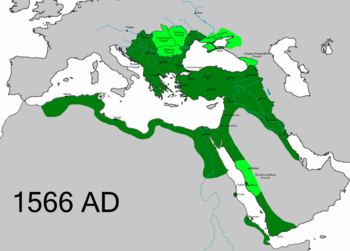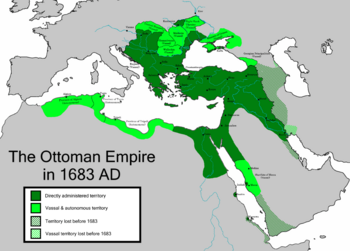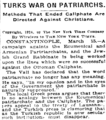Ottoman Caliphate facts for kids
Quick facts for kids
Ottoman Caliphate
خلافت مقامى
Hilâfet makamı |
|||||||
|---|---|---|---|---|---|---|---|
| 1517–1924 | |||||||
| Capital | Constantinople | ||||||
| Working languages | Ottoman Turkish (dynastic) Arabic (religious) |
||||||
| Religion | Sunni Islam | ||||||
| Government | Hereditary caliphate under an empire (1517–1922) Elective caliphate under a parliament (1922–1924) |
||||||
| Caliph | |||||||
|
• 1517–1520
|
Selim I (first) | ||||||
|
• 1922–1924
|
Abdulmejid II (last) | ||||||
| Established | |||||||
|
• Al-Mutawakkil III formally surrenders his title over to Selim I
|
1517 | ||||||
|
• Treaty of Küçük Kaynarca
|
1774 | ||||||
|
• Declaration of jihad by the Ottoman Empire
|
1914 | ||||||
|
• Abolition of the Caliphate
|
1924 | ||||||
|
|||||||
The caliphate of the Ottoman Empire was a special role claimed by the leaders of the Turkish Ottoman dynasty. They said they were the caliphs of Islam from the 1500s to the early 1900s. A caliph is seen as a leader of the Muslim world.
This claim grew stronger after the Ottomans conquered Mamluk Egypt in 1517. Sultan Selim I became the protector of the holy cities of Mecca and Medina. This made the Ottoman rulers seem like the main leaders in the Muslim world.
The Ottoman Caliphate eventually lost its power. This happened as Western countries grew stronger and the Ottoman Empire itself began to break apart. The last Ottoman caliph, Abdulmejid II, held his title for a few years. But in 1924, Mustafa Kemal Atatürk led changes that ended the caliphate. The Ottoman royal family was sent away from Turkey.
During the time of the Ottoman Caliphate, a mystical side of Islam called Sufism became very popular. This was helped by the creation of Sufi groups like the Bayramiyya and Mawlawiyya.
History of the Ottoman Caliphate
From Selim I to Abdulaziz (1517–1876)
In 1517, the Ottoman sultan Selim I defeated the Mamluk Sultanate in Cairo. The last caliph in Cairo, Al-Mutawakkil III, was taken to Constantinople as a prisoner. It is said that he officially gave his title of caliph to Selim. He also gave Selim important items like the sword and cloak of Muhammad.
This event made the Ottoman sultans the new caliphs. Over time, they were seen as the true leaders of the Islamic world. From Constantinople, the Ottoman sultans ruled a huge empire. It included Anatolia, most of the Middle East, North Africa, and parts of Eastern Europe.
European countries became much stronger after events like the Industrial Revolution. The Ottoman Empire struggled to keep up with Europe's new technology and military power. Because of this, the empire slowly lost its strong position.
The title of caliph was first used for political reasons in 1774. The Ottomans used it to respond to the Russians. Russia claimed they needed to protect Orthodox Christians in the Ottoman Empire. So, the Ottomans made a similar claim about Muslims living in Russia. The British also supported the Ottoman claim. They had the Ottoman caliph issue orders to Muslims in British India. These orders told them to support the British government.
In the 1800s, the Ottoman Empire started a period of change called the Tanzimat. This made the Ottoman state more powerful, even though it lost some land. However, the empire still could not match the military strength of its main rival, the Russian Empire. It lost several wars against Russia. The Ottoman government also ran out of money in 1875–76.
The British government believed the Ottomans were the Caliphs of Islam. This helped them with Muslims in British India. In return, Ottoman sultans like Selim III and Abdulmejid I told Indian Muslims to support British rule.
Sultan Abdul Hamid II (1876–1909)
Sultan Abdul Hamid II ruled from 1876 to 1909. He believed that strong leadership was needed to save the empire. He took more power for himself, trusting fewer of his officials. He also focused on the empire's "Islamic" identity. He stressed his role as the Caliph and called for Muslims to unite under the Caliphate.
Abdul Hamid made the empire stronger for a while. He built many schools and reduced the national debt. He also started projects to improve the empire's roads and buildings.
In 1899, the Ottomans helped the United States government. They used their religious power as caliphs to order the Sultanate of Sulu to stop fighting. The Sultan of Sulu, Jamalul-Kiram II, followed the caliph's order and surrendered to the Americans.
In 1909, a group of military officers called the Young Turks took control. They wanted to modernize the empire like Western countries. They forced Abdul Hamid to bring back the parliament and constitution. This made the caliphate lose much of its power.
Changes and Revolts (1909)
After the Young Turks took power, some soldiers loyal to the sultan tried to fight back. This counter-coup failed. Abdul Hamid was removed from power on April 13, 1909. His brother, Rashid Effendi, became the new sultan, Mehmed V.
Sultan Mehmed V (1909–1918)
Loss of Territory
In 1911, Italy fought the Ottomans over Libya. Turkey's failure to defend these areas showed how weak its military was. In 1912, several Balkan countries formed an alliance against the Ottomans. They attacked the empire in the Balkan Wars. The Ottomans lost almost all their remaining land in Europe.
Inside the empire, political problems continued. Nationalist uprisings became more common. People were frustrated with poor leadership and military losses. In 1913, the Young Turks took complete control of the government. The sultan, Mehmed V, became a puppet ruler. The real power was with the Young Turks.
World War I and the Call for Jihad
When World War I started in Europe, the Young Turks allied with Germany. This decision had terrible results. The Ottoman Empire joined the war in November 1914. Britain, France, and Russia immediately declared war on the Ottomans. The empire's situation got worse during the war. Even its heartland in the Middle East was soon lost.
The Young Turks made the sultan, as Caliph, declare a jihad. This was a call for all Muslims to fight against the Allied forces. But this effort was mostly unsuccessful. The Young Turk government resigned, and its leaders fled Turkey. Sultan Mehmed VI agreed to stop fighting. The Armistice of Mudros was signed on October 30, 1918. Allied troops soon occupied Constantinople.
End of the Empire
By the end of the war, the Ottomans had lost almost their entire empire. The sultan tried to save his throne by working with the Allies. He dissolved parliament and allowed the Allies to control the government.
The Khilafat Movement
The Khilafat movement (1919–1922) was a political campaign in British India. It protested British plans to break up Turkey after World War I. Leaders like Shaukat Ali and Mohammad Ali Jauhar wanted to restore the Ottoman Caliphate. Others aimed to protect Muslim interests.
Mahatma Gandhi supported this movement. He saw it as part of his fight against the British Empire. He also promoted a wider non-cooperation movement at the same time. This movement was known for bringing Hindus and Muslims together. It ended in 1922.
Abolition of the Caliphate
The Turkish national movement began to fight for Turkey's independence. They formed a Turkish Grand National Assembly in Ankara in 1920. On October 29, 1923, the National Assembly declared Turkey a republic. Ankara became its new capital. After more than 600 years, the Ottoman Empire officially ended.
At first, the National Assembly seemed willing to keep the Caliphate. They appointed Mehmed's cousin, Abdülmecid, as caliph in November 1922. But his position had no real power. Abdülmecid's role was purely ceremonial and short-lived. Mustafa Kemal Atatürk was a strong critic of the Ottoman royal family. When Abdülmecid became caliph, Kemal refused to allow the traditional ceremony. He clearly stated that the Caliph had no power.
When Abdülmecid asked for more pay, Kemal wrote: "Your office, the Caliphate, is nothing more than a historic relic. It has no justification for existence."
Even so, Kemal did not immediately abolish the Caliphate. It still had a lot of support from ordinary people.
Then, in 1924, two Indian brothers, Mohammad Ali Jauhar and Maulana Shaukat Ali, wrote pamphlets. They asked the Turkish people to save the Ottoman Caliphate. Turkey's new government saw this as foreign interference. They called it an insult to Turkey's independence and a threat to its safety. Kemal quickly used this chance. On March 3, 1924, the National Assembly abolished the Caliphate. Abdülmecid and the rest of the Ottoman family were sent into exile. Mustafa Kemal Atatürk offered the caliphate to Ahmed Sharif as-Senussi. But Senussi refused and supported Abdulmejid.
See also
- Islam in the Ottoman Empire
- Ottoman claim to Roman succession
- Vassal and tributary states of the Ottoman Empire
Images for kids
-
"Turks War on Patriarchs", following the Abolition of the Caliphate as reported in The New York Times, 16 March 1924









